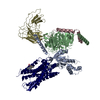+検索条件
-Structure paper
| タイトル | Structure-based identification of a G protein-biased allosteric modulator of cannabinoid receptor CB1. |
|---|---|
| ジャーナル・号・ページ | Proc Natl Acad Sci U S A, Vol. 121, Issue 24, Page e2321532121, Year 2024 |
| 掲載日 | 2024年6月11日 |
 著者 著者 | Siyuan Shen / Chao Wu / Guifeng Lin / Xin Yang / Yangli Zhou / Chang Zhao / Zhuang Miao / Xiaowen Tian / Kexin Wang / Zhiqian Yang / Zhiyu Liu / Nihong Guo / Yueshan Li / Anjie Xia / Pei Zhou / Jingming Liu / Wei Yan / Bowen Ke / Shengyong Yang / Zhenhua Shao /  |
| PubMed 要旨 | is known for its therapeutic benefit in various diseases including pain relief by targeting cannabinoid receptors. The primary component of cannabis, Δ9-tetrahydrocannabinol (THC), and other ... is known for its therapeutic benefit in various diseases including pain relief by targeting cannabinoid receptors. The primary component of cannabis, Δ9-tetrahydrocannabinol (THC), and other agonists engage the orthosteric site of CB1, activating both Gi and β-arrestin signaling pathways. The activation of diverse pathways could result in on-target side effects and cannabis addiction, which may hinder therapeutic potential. A significant challenge in pharmacology is the design of a ligand that can modulate specific signaling of CB1. By leveraging insights from the structure-function selectivity relationship (SFSR), we have identified Gi signaling-biased agonist-allosteric modulators (ago-BAMs). Further, two cryoelectron microscopy (cryo-EM) structures reveal the binding mode of ago-BAM at the extrahelical allosteric site of CB1. Combining mutagenesis and pharmacological studies, we elucidated the detailed mechanism of ago-BAM-mediated biased signaling. Notably, ago-BAM demonstrated analgesic efficacy with fewer side effects, minimal drug toxicity and no cannabis addiction in mouse pain models. In summary, our finding not only suggests that ago-BAMs of CB1 provide a potential nonopioid strategy for pain management but also sheds light on BAM identification for GPCRs. |
 リンク リンク |  Proc Natl Acad Sci U S A / Proc Natl Acad Sci U S A /  PubMed:38830102 / PubMed:38830102 /  PubMed Central PubMed Central |
| 手法 | EM (単粒子) |
| 解像度 | 3.3 - 3.4 Å |
| 構造データ | EMDB-35511, PDB-8ikg: EMDB-35512, PDB-8ikh: |
| 化合物 | 
ChemComp-Q2B: 
ChemComp-Q2L: |
| 由来 |
|
 キーワード キーワード | MEMBRANE PROTEIN / complex / allosteric modulator |
 ムービー
ムービー コントローラー
コントローラー 構造ビューア
構造ビューア 万見文献について
万見文献について







 homo sapiens (ヒト)
homo sapiens (ヒト)
